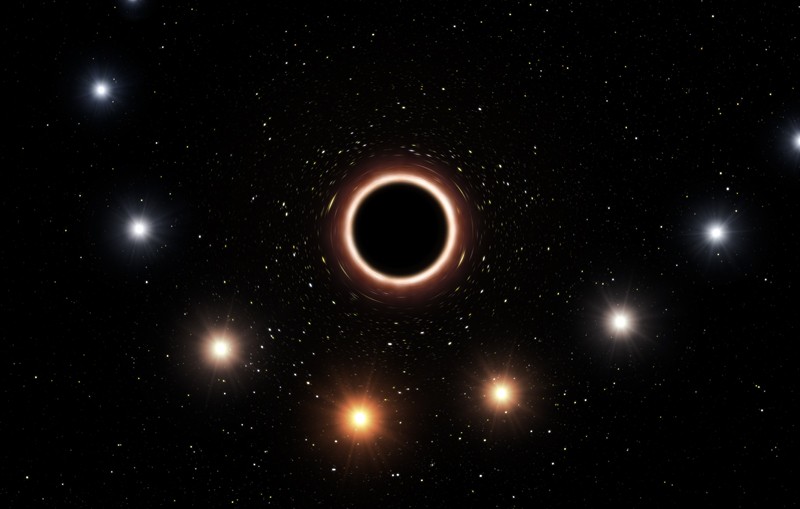 |
| As the star S2 passes by the black hole at the galactic centre, the strong gravitational field causes its light to shift towards the red ends of the spectrum (artist’s impression).Credit: ESO/M. Kornmesser |
A Sense of Doubt blog post #1289 - Milky Way's Black Hole
Just a share. Grading robot is roboting.
FROM - https://www.nature.com/articles/d41586-018-05825-3
Milky Way’s black hole provides long-sought test of Einstein’s general relativity
Astronomers have caught the giant black hole at our galaxy’s centre stretching the light emitted by an orbiting star — nearly three decades after they first starting tracking the star. The long-sought phenomenon, known as gravitational redshift, was predicted by Einstein’s general theory of relativity, but until now it had never been detected in the environs of a black hole.
“It’s another big step in getting closer to understanding the black hole,” says Heino Falcke, an astronomer at Radboud University in Nijmegen, the Netherlands, who was not involved in the research. “This is just amazing, to be able to see these effects.”
A team led by Reinhard Genzel, of the Max Planck Institute for Extraterrestrial Physics in Garching, Germany, announced the discovery today at a press conference and reports the results in Astronomy & Astrophysics1. The group includes scientists from universities and research institutions in Germany, France, Portugal, Switzerland, the Netherlands, the United States and Ireland.
Genzel and his colleagues have tracked the journey of this star, known as S2, since the early 1990s. Using telescopes at the European Southern Observatory in Chile, the scientists watch it as it travels in an elliptical orbit around the black hole, which lies 26,000 light years from Earth in the constellation Sagittarius. With a mass 4 million times that of the Sun, the black hole generates the strongest gravitational field in the Milky Way. That makes it an ideal place to hunt for relativistic effects.
On 19 May this year, S2 passed as close as it ever does to the black hole. The researchers traced the star’s path using instruments including GRAVITY, an interferometer that combines light from four 8-meter telescopes and that became operational in 2016. “With our measurements the door is wide open to black-hole physics,” says team member Frank Eisenhauer, an astronomer at the Max Planck institute.
 |
| A time-lapse of observations from the European Southern Observatory’s telescope in Chile showing stars orbiting the Milky Way’s central black hole over 20 years.Credit: ESO/MPE |
GRAVITY measured S2’s movement across the sky; at its fastest, the star whizzed along at more than 7,600 kilometres a second, or nearly 3% the speed of light. Meanwhile, a different instrument studied how fast S2 moved towards and away from Earth as it swung past the black hole. Combining the observations allowed Genzel’s team to detect the star’s gravitational redshift — which describes how its light is stretched to longer wavelengths by the black hole's immense gravitational pull. Such a phenomenon is consistent with the predictions of general relativity.
“What we measured cannot be described by Newton any more,” says Odele Straub, an astrophysicist at the Paris Observatory. Future observations of S2 might confirm other Einstein predictions, such as how a spinning black hole drags space-time around with it.
“Their data look beautiful,” says Andrea Ghez, an astronomer at the University of California, Los Angeles, who leads a competing team that uses the Keck telescopes in Hawaii to measure the star’s path around the galactic centre.
It takes 16 years for S2 to make a complete orbit around the black hole, so both groups have been eagerly awaiting this year’s close passage. But Ghez says that her team plans to wait until later in the year to publish its results. Of three crucial events happening in 2018, only two have taken place so far.
In April, S2 reached its maximum velocity in the line of sight from Earth. In May, it made its closest approach to the galactic centre. And in late August and early September, it will slow to its minimum velocity in the line of sight from Earth. “It’s taken us 20 years to get to this moment,” Ghez says. “We’re going to wait until the end of the passage, until the star will be done with whatever it’s going to do.”
S2 has already begun slowing down, in its direction of travel as seen from Earth, as the third event approaches. And both the US and the European teams are watching it closely. “We’re in the thick of it,” says Ghez. “It’s super-exciting.”
++++++++++++++++++++++++++++++++++++++++++++++++++++++++++++++++++++++++++++++++++++++++++++++++++++++++++++++++++++++++++++++++++++++++++++++
+++++++++++++++++++++++++++++++++++++++++++++++++++++++++++++++++++++++
- Bloggery committed by chris tower - 1809.01 - 10:10
- Days ago = 1155 days ago
- New note - On 1807.06, I ceased daily transmission of my Hey Mom feature after three years of daily conversations. I plan to continue Hey Mom posts at least twice per week but will continue to post the days since ("Days Ago") count on my blog each day. The blog entry numbering in the title has changed to reflect total Sense of Doubt posts since I began the blog on 0705.04, which include Hey Mom posts, Daily Bowie posts, and Sense of Doubt posts. Hey Mom posts will still be numbered sequentially. New Hey Mom posts will use the same format as all the other Hey Mom posts; all other posts will feature this format seen here.
No comments:
Post a Comment